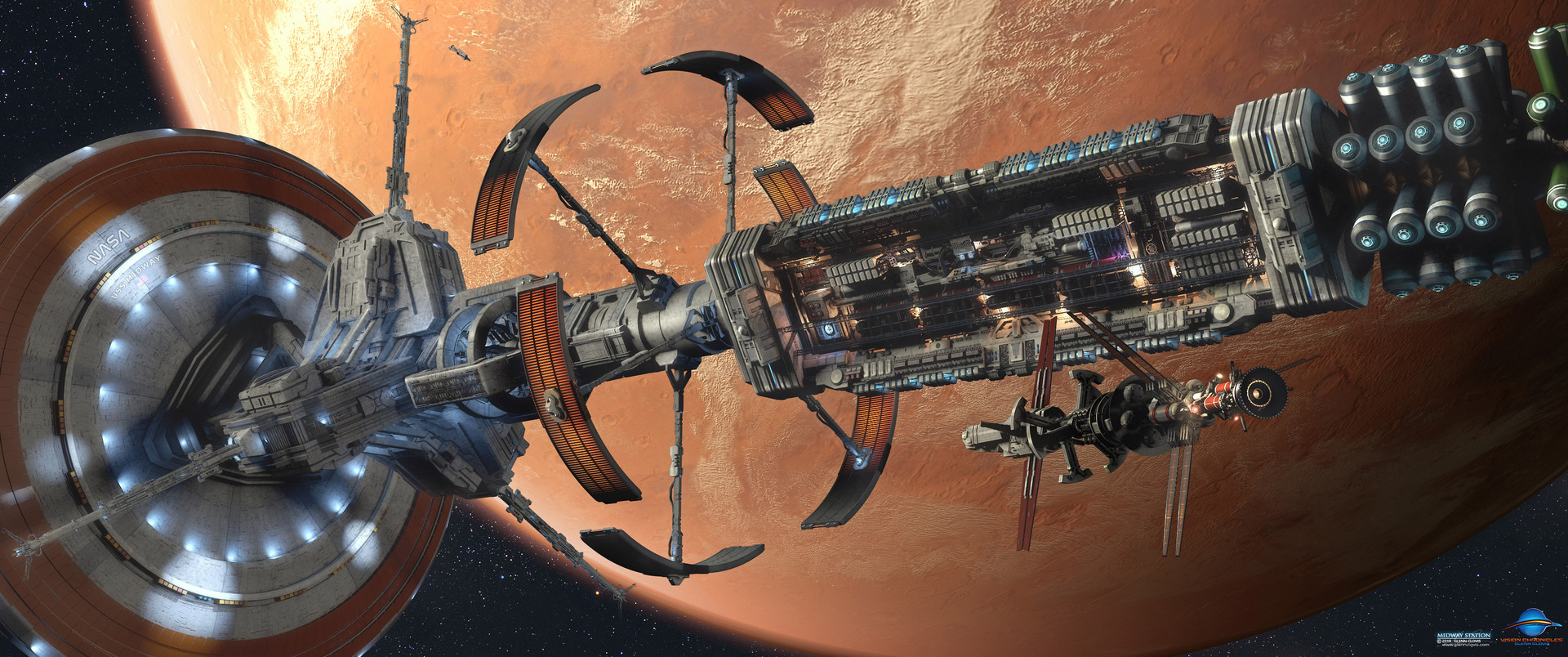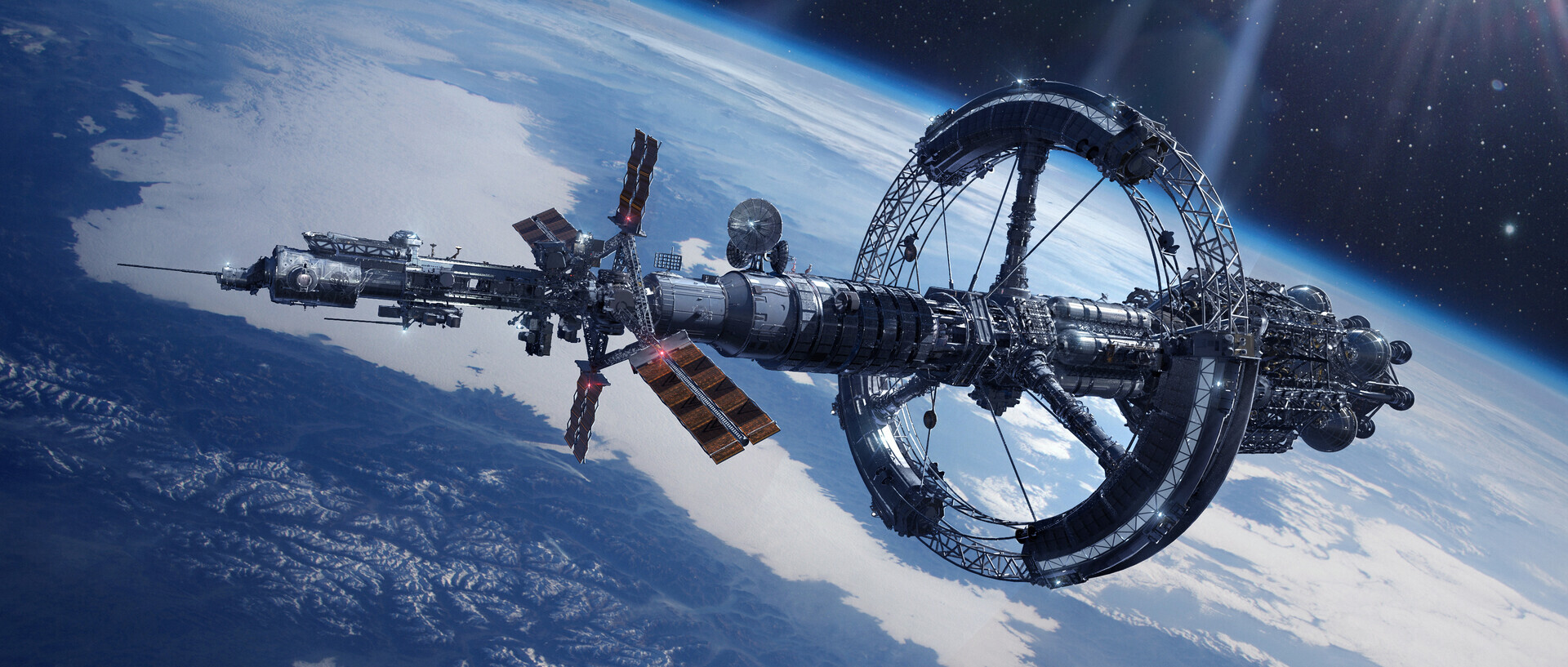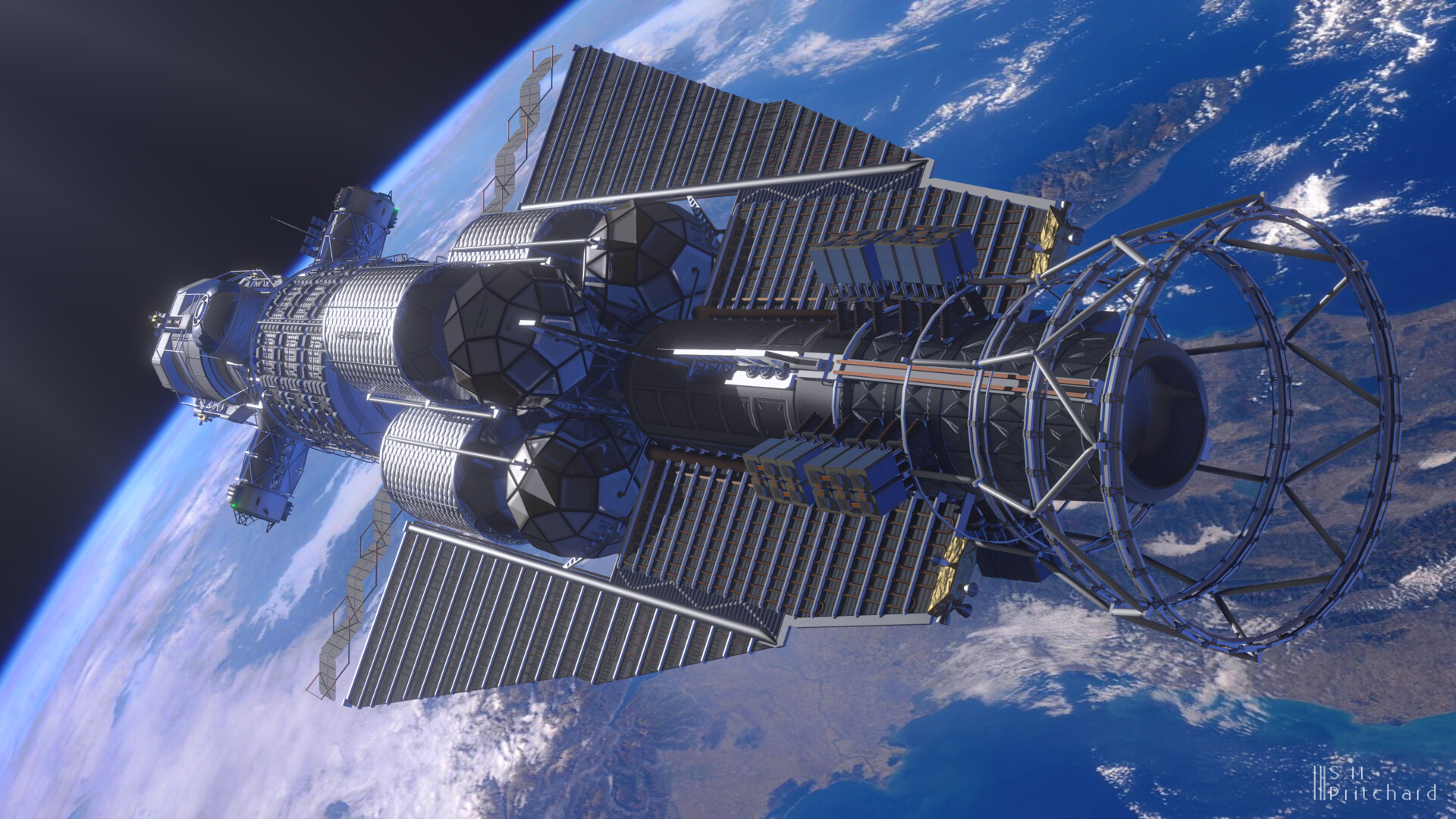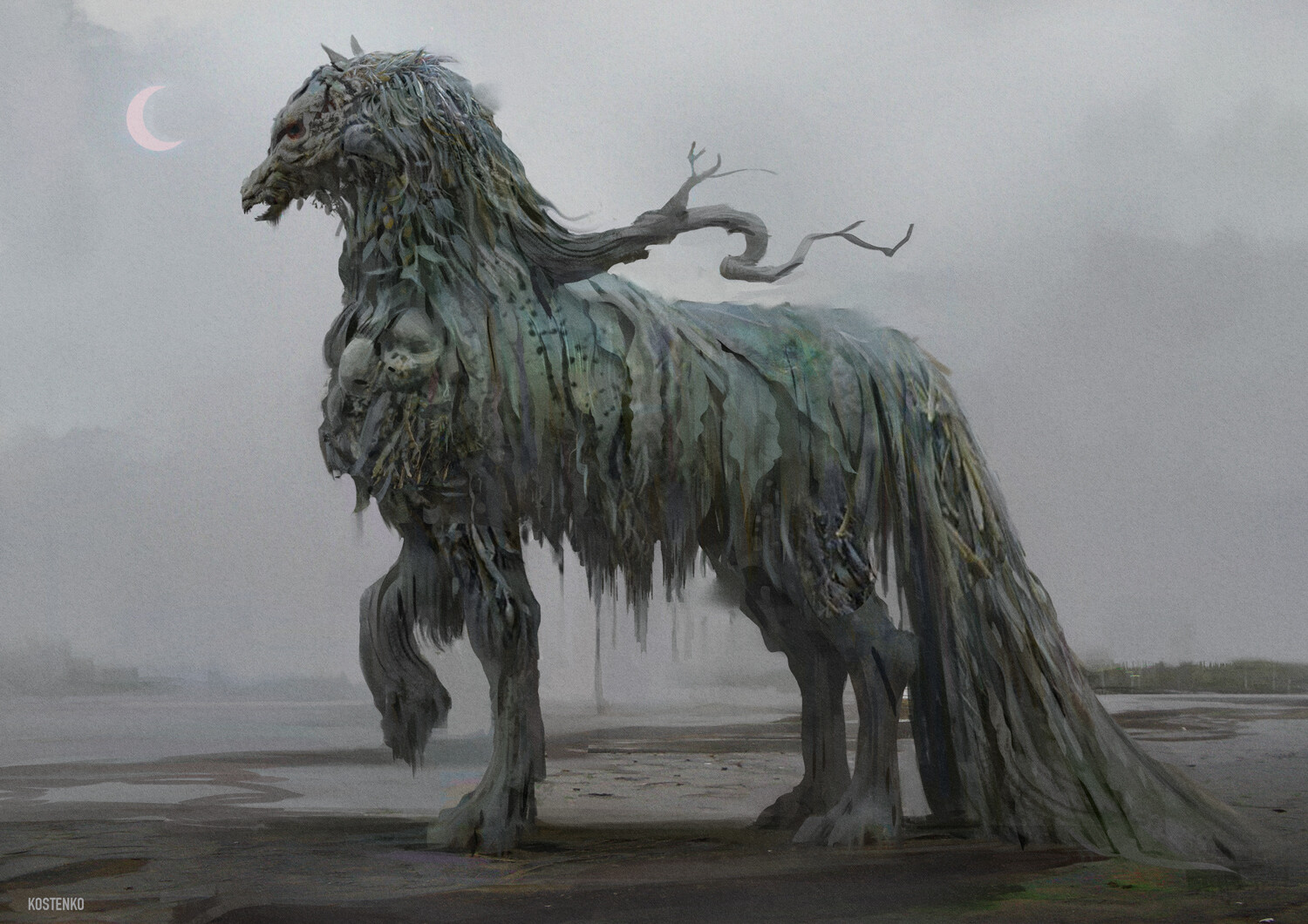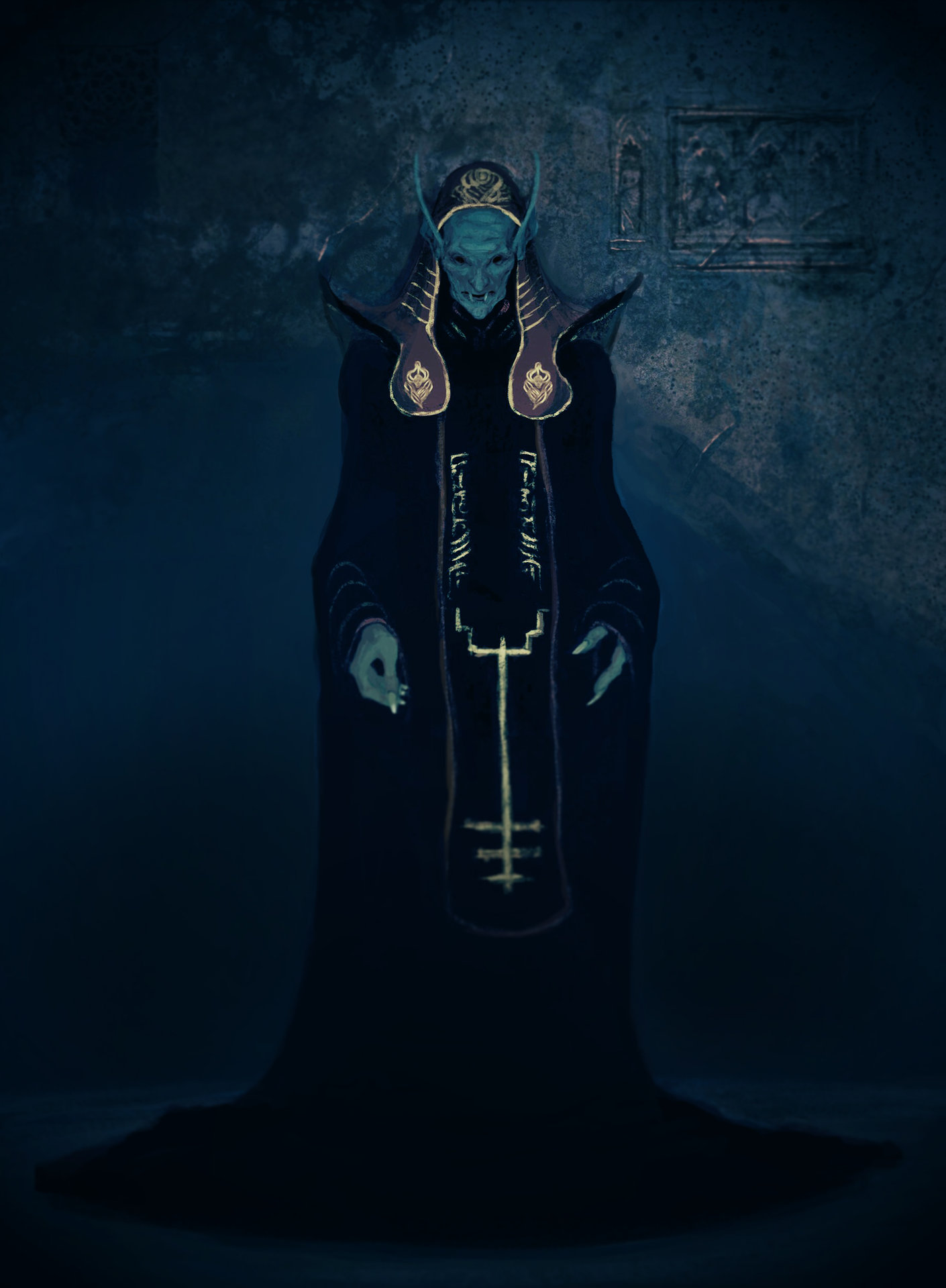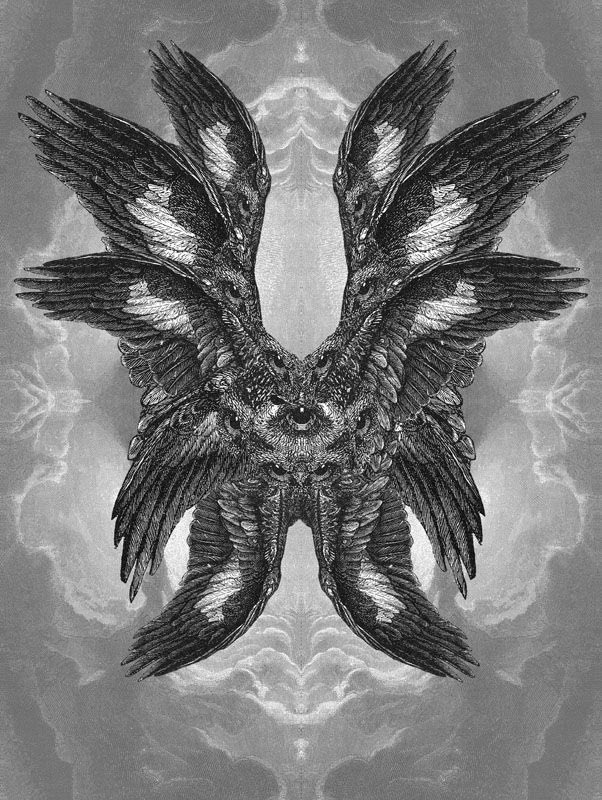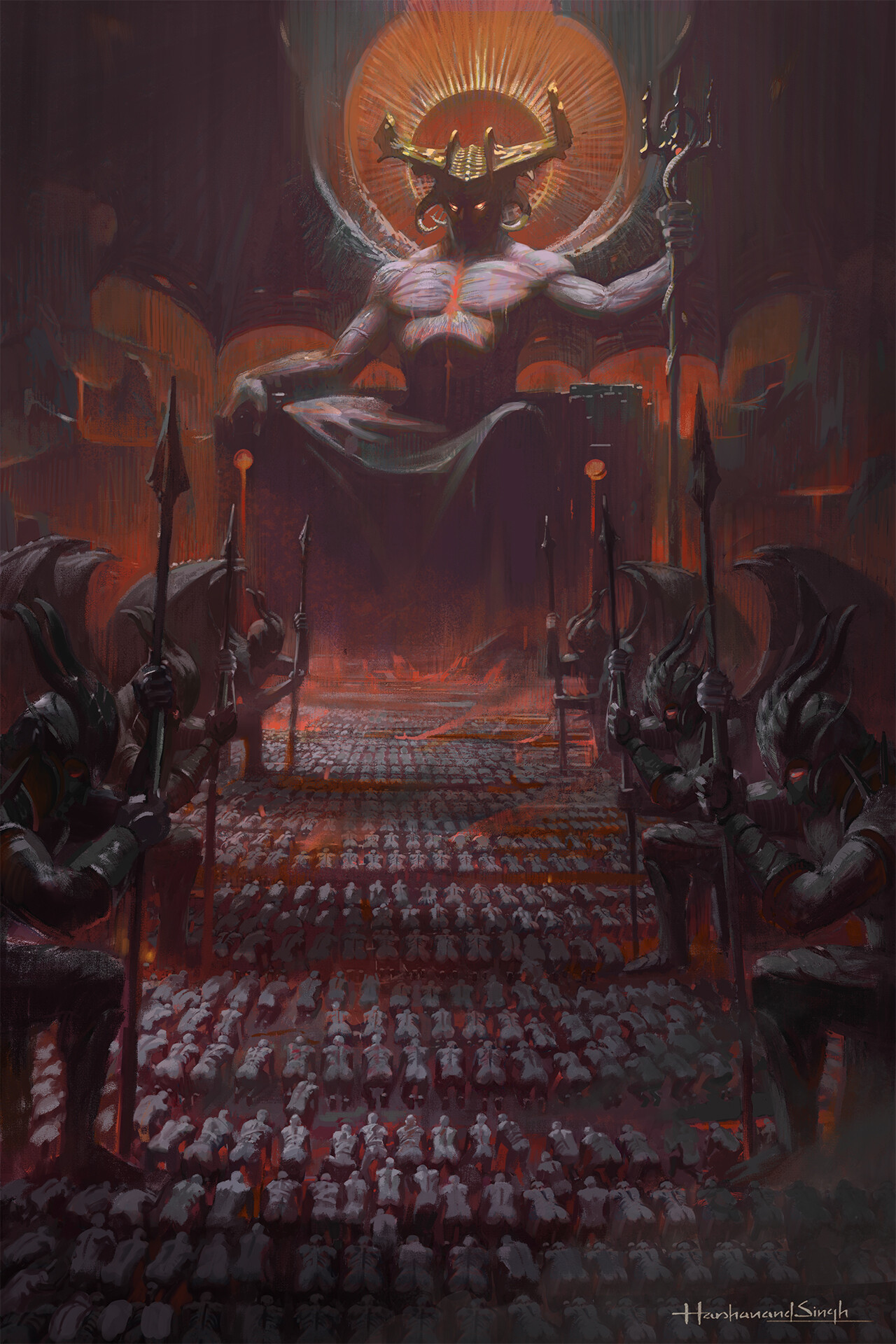In my previous post I gave a few thoughts on a rough Mothership setting. Have some more. Note: I am not a physicist so the below is probably very wrong. As I have now disclaimed this fact you can't be mad at me.
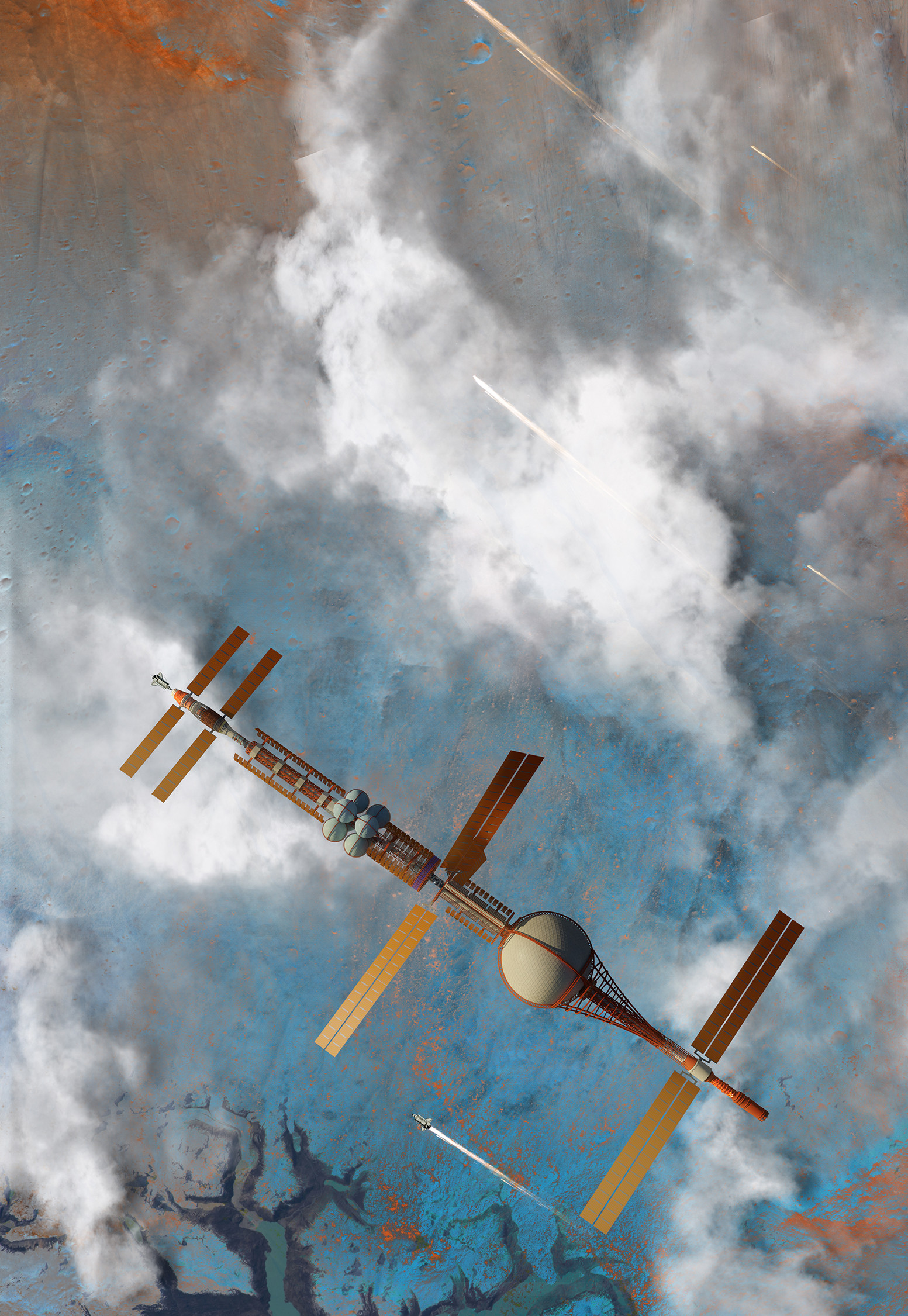 |
| Marnix Rekkers |
I previously mentioned that:
Starships are many and varied. They share this in common: Newton's laws are supreme, artificial gravity is provided by acceleration G- or centrifugal force, and waste heat is a constant enemy. Expect rotating crew quarters, G-force couches, heatsinks and radiators, and barebones design. Very few spacecraft are able to touch down on anything near Earth-gravity planets due to their non-aerodynamic design and the fact that many use fusion torches for void propulsion which would eject a nasty amount of fallout into a planetary biosphere - most have a spaceplane and/or rely on some form of orbital infrastructure to reach ground level and return to orbit...As I'm aiming for a reasonably hard sci-fi approach (magic FTL notwithstanding) this presents a couple of circles to be squared in the Mothership Player's Survival Guide, in no particular order:
- Fighter-class ships
- Thruster speed, fuel use, and alternative propulsion
- Jump drives
- Stealth, G-forces, weapons, and heat
- General ship design points
Fighter-class ships
Do not exist. Allow me to explain. Warplanes fulfil a niche in terrestrial warfare because they're fast and mobile, can attack targets beyond the horizon out of sight of your big slow vehicles and ships, and they can move through the atmosphere reasonably efficiently. In void warfare there is no horizon preventing your big guns from targeting the enemy directly and there is no atmosphere whose constraints you must consider while moving - there is no reason to close to knife-fighting range.
Furthermore, an atmospheric fighter has the advantage of not requiring life support (beyond compressed air and heating for high-altitude flight) and being able to rely on atmospheric drag and planetary gravity to aid in braking. Void craft do not have this luxury - organic crew require life support, increasing the mass of the craft, and rather than braking via drag a spacecraft must apply thrust in a different direction to slow down/change vector which requires fuel and applies (potentially fatal) G-forces to the organic pilot depending on the acceleration/deceleration. Factor in the additional mass/energy requirements for ammunition or other weapons and you add a greater need for fuel as more mass = more energy to move said mass.
The final knife in the coffin, so to speak, is survivability. Void warfare stands to be a slugfest - there's no 'cover' in space short of hiding behind a planet so once a fight starts you're almost guaranteed to be hit by something as CIWS and EM countermeasures will never be 100% successful. Surprise, physics rears its head again here - a critical factor to consider in a void battle is the amount of surface area your ship has vulnerable to attack as this presents greater opportunities for your enemy to penetrate your hull and smash up vital systems. More surface area will require more armour to protect, which means more mass, more fuel etc. etc. etc.. It may seem like a small fighter would make sense then, as it's smaller and has less surface area. However the laws of physics dictate that the more massive an object is, the lower its surface area proportional to a less massive object. This has huge ramifications for void warfare - a larger ship is inherently more massive with the difficulties that entails but you enter a sort of economy of scale beyond a certain point. You can have a large vessel with high mass but if you arrange it in a compact shape you can concentrate said mass into a low-surface area, pile your crew and vital components in the middle surrounded with armour and end up with an order of magnitude more survivability than a fighter-size vessel. Add the fact that a larger vessel means a bigger reactor and storage room = more missiles, railgun rounds, bigger, better lasers, more fuel (and thus greater delta-v capacity) and bigger engine (meaning better acceleration) and it's a no-brainer. Space fighters are vulnerable, weak and limited in range and scope.
A far better solution would be to strip out the life support, up the armour, reactor and weapons and install an expert system with a control link back to a command ship - essentially turn it into a drone. Or use more missiles. Either way you avoid sending fleshy pilots to almost certain doom.
 |
| Ben Nicholas |
Thruster speed, fuel use, and alternative propulsion
Speed is a bit of a red herring in space as everything moves super fast - being in an orbit is essentially moving laterally quick enough to miss the ground as gravity pulls you down. As such, any spacecraft is capable of picking up fantastic amounts of speed but what really matters is the ability to change speed and direction and the acceleration/deceleration forces one can bring to bear - delta-v is king. The Mothership core rules use Speed as a catch-all movement stat for starships - it's used for determining the success of complex piloting manoeuvres and as a measure of speed relative to other ships. More ship Thrusters = higher speed in the rules as written. There is also the concept of Fuel, which is used to activate the Jump drive (requiring double the Jump rating in fuel) and using thrusters burns 1 unit of fuel/day. Each engine unit also requires 3 fuel, plus additional fuel as required*. All perfectly serviceable, but not hard sci-fi enough for what we're aiming for:
- Starships do not need to fire their thrusters to maintain a continual speed, only to accelerate/decelerate or change direction, thus there is no flat usage of fuel per day when travelling in space.
- I think an 'Engine' probably refers to a reactor of some kind as it references powering the whole ship. I will treat it as such. In a fusion drive (assuming direct thrust) the thrusters function independently of a ship's reactor, fusing He3 and directing the exhaust out the back of the ship, which breaks the required link between Engines and Thrusters in the ship design rules. I like the idea of a ship's reactor powering the Jump drive.
- A larger drive (in this case higher thruster level) does allow for greater speed/acceleration (specifically a bigger rocket can produce more thrust) but each manoeuvre undertaken by a starship requires fuel to change speed and direction.
*Note: I don't quite get this bit as fuel adds to the total hull requirement but can be stored in cargo space - maybe they mean dedicated fuel storage? - also the engine units can apparently burn fuel at a rate of 1/day under thruster power but require a minimum of 3 fuel each when building the ship?).
With the above in mind, I'd propose the following reforms:
Interplanetary Travel - Thrusters & Fuel
In a ship equipped with a fusion drive burning He3 Speed represents the maximum acceleration possible by a ship. Keep the current thruster > speed relationship as written - a larger thruster means higher acceleration can be reached.
Instead of burning 1 fuel/day of travel instead divide a system into zones of interest - a 'zone' is a planet (and its moons), star, deep space observatory etc.. Basically anything interesting in a system and its surrounds is a 'zone' and travelling between these locations takes at minimum 1 unit of fuel to get up to speed and decelerate when approaching the destination. Zones are stacked from the inner system to the outer edge so to travel from an inner system zone to an outer system zone you'd need to account for travelling through the intervening zones. As larger thrusters mean more fuel can be used they can achieve higher acceleration - a ship with a speed of 10 can only burn 1 fuel, but a ship with 20 can burn 2, a ship with 30 can burn 3, and so on.
A ship burning a speed 10 fusion torch can travel from one zone to another in 4 weeks (based on Project Rho's low-end torchship calculations). Burning additional fuel in a higher-rated thruster reduces this travel time exponentially:
- A speed 20+ ship burning 2 fuel will make it in 2 weeks.
- A speed 30+ ship burning 3 fuel in 1 week.
- A speed 40+ ship burning 4 fuel will make it in 4.5 days.
- A speed 50+ ship burning 5 fuel will make it in 2.25 days.
- A speed 60+ ship burning 6 fuel will make it in just over a day.
- A speed 70+ ship burning 7 fuel will make it about half a day.
- A speed 80 ship burning 8 fuel will make it in ~6 hours.
The latter stages begin to get into the region of relativity but the distances travelled are generally so short (astronomically) that this won't have much of an effect. Established planetary governments do, however, tend to take issue with objects approaching c near them and so generally enforce a sort of stellar speed limit (the penalty for speeding is nuclear annihilation and/or parking something in your path before you can turn). A major issue with travelling at the higher tiers is the sheer amount of fuel needed to do so - unless you're in a real hurry and/or have very deep pockets it's usually easier to sit in the slow lane and enjoy the downtime - and the G-forces involved on the crew in such a rapid acceleration over a relatively short patch of spacetime (speed 80 = ~10g for several hours).
This is of course an abstraction - a speed 10 ship could in theory perform subsequent or continual burns to speed up but my reasoning is that zone-to-zone travel on the scale of fractions of AUs means that by the time a smaller thruster has completed its initial burn (larger thruster = more propellant can be fired at once) and accelerated they're either at or approaching the point where they need to perform a retrograde burn to begin decelerating on approach to their destination. This also ignores the movement of planetary orbits, I've tried to take an 'average' value rather than spending time calculating the 'season' people are travelling in.
What can I say? I'm not actually a rocket scientist.
Interstellar Travel - Thrusters & Fuel
If you're not using a Jump drive then the Warden can rule this as they see fit. Using the above example a speed 80 ship (assuming zone-to-zone travel on the scale of 6 hours/AU (150 million kilometres)) accelerating at 10g could cross the distance between Earth and Centauri (~4.25ly) in about 9 months with a time debt of ~4.5 years. However, this would take absolutely astronomical (heh) amounts of fuel - assuming a dry weight of 500 tons would mean over 1 million tons of fuel required to maintain constant acceleration. The ship would almost certainly have to coast for the majority of the journey, which would massively increase the time taken - potentially up to centuries.
Intergalactic Travel - Thrusters & Fuel
Alternative propulsion and planetary landings
The above assumes the widespread use of relatively efficient fusion drives throughout human space, but there are other options available as well for systems with well-developed stellar infrastructure.
Solar sails are a viable and cheap option for intra-system travel - bind aluminium to a tough but flexible polymer sheet, make the sheet a sufficient size (kilometres across - an 800m square sail catches ~5 newtons of force at the Earth's distance from Sol, which drops as you get further out) to pull the payload at a suitable speed and let the sun's radiation do the work. Using gravity assists and solar wind alone means for a relatively slow journey, but with sufficiently advanced space infrastructure it would be quite trivial to set up a laser network capable of accelerating/decelerating solar sail craft. As a general rule assume a solar-propelled craft can travel zone-to-zone in about 6 months when receiving a gravity assist from a star (based off the predicted travel times for our solar system). If laser-boosted, however, use the travel times per fusion craft with speed scaling according to the system's development. A system with a laser propulsion network may well require craft approaching void habitats or inhabited planets to deploy a sail and use specific 'space lanes' rather than letting lit fusion torches near habitable worlds - anything capable of applying the energy required for such high acceleration essentially has a huge weapon attached to its rear end.
Ion thrusters have the advantage of being very efficient and can reach high speeds given enough acceleration time but are unfortunately not very powerful. They're useful for deep-space probes that will be travelling for decades and centuries, satellites/stations readjusting orbits but generally lack utility on spacecraft.
In general assume that starships are designed for use in space only and cannot land on planets with an atmosphere and/or anything higher than lunar gravity (0.166g). As I mentioned previously, most will have a dedicated aerodynamic spaceplane either independently capable of single-stage-to-orbit flight (using new types of rocket fuel, dual scramjet/rocket designs, nuclear lightbulbs, or another solution) or relying on assisted launches from launch loop(s), orbital infrastructure like an orbital ring, and/or space elevator(s) (which would remove the need for a separate orbital vehicle entirely). A developed planet with similar gravity to Earth would be able to provide the former but a less developed frontier world may rely on skyhooks or old fashioned chemical rocket launches. The lower the gravity of a given planet, the easier achieving orbit is - low gravity environments can easily achieve orbital trajectories via mass driver, for instance, whereas Earth-gravity planets would need to supplement such a solution with additional thrust from rockets or ground-based lasers.
 |
| space gooose |
Jump drives
In the Player's Survival Guide actual Jump distances and procedures are left up to the Warden but are stated to be subject to irregular effects of relativity. My adaptation for this is as follows:
Jump rating is the number of parsecs that can be crossed per week (as perceived by the crew) in hyperspace. Jumps always take 1 week from the crew's perspective. Entering hyperspace requires a starship to be at the edge of a system's gravity well in order to create a stable hyperspace bridge - the Jump drive works by searching for a suitable 'mass shadow' and plotting a hyperspace course towards it. The ship can exit from hyperspace once they reach the limits of the target system. Attempting to Jump while within a system is virtually guaranteed to end catastrophically. The real time spent in hyperspace can vary, but on a well-executed Jump on a reliably-plotted route crew time and observer time will generally match, and any route with a known timelag can be accounted for.
Hyperspace is, by its very nature, alien, corrosive, and counter-intuitive to human minds and the very properties that allows starships to bypass relativity when travelling through hyperspace also lead to hyperspace routes shifting and changing over time. Most spacers liken hyperspace to an ocean with tides and currents - by mapping and plotting reliable routes travel disruption can be minimised, and most port authorities demand that berthing ships share anonymised hyperspace route data as a condition of receiving services. This data is then used to update the minute shifts in hyperspace conditions for the given route and is transmitted out to other ships for navigation purposes. Jumping into a less travelled route could mean that hyperspace conditions are wildly different to what the data indicates - most of the time this will mean a greater outmatch between observer and crew time but sudden and violent shifts (so-called 'hyperspace storms') can lead to ships arriving months or years late, at wildly different destinations, or even suffering damage and destruction at the hands of surging metadimensional currents. Bear in mind that this data sharing relies on receiving regular traffic - a backwater system may not be able to provide up-to-date course bearings if you're the only out-of-system ship they've seen recently.
Jump procedure
A ship's computer is able to plot and execute a Jump based on the most recent astrogation data available - it will tell you the status of the route:
- Uncharted/untravelled for >1 year - timelag effects unknown, high likelihood of danger to ship and crew.
- Untravelled for 6-12 months - likely timelag ≥1 Standard year.
- Untravelled for 2-6 months - likely timelag of 1d6 Standard months.
- Untravelled for up to 1 month - likely timelag of 1d4 Standard weeks.
- Travelled within last 2 weeks - time asynchronicity within acceptable parameters.
It will also mention any known hyperspace conditions, like known danger zones or patches that slow or speed travel for whatever reason. I've not done a list for these as I figured that the above would be sufficient and additional features can be made up on the fly as appropriate.
If attempting to plot a Jump while in combat or undertaking some other stressful task an Intellect/Astrogation or Hyperspace check may be called for - the Warden can determine any deleterious effects caused by a failure. Radiator panels and other external instruments are normally retracted if possible to keep them well within the realspace bubble.
All organic crew must enter cryosleep for the duration of the journey and androids a hibernation state. The effects of hyperspace on the human psyche are well-documented - human minds gradually deteriorate if left awake while undergoing a Jump. Chillingly, a similar effect is seen in active persona cores leading to an intense study on the effects of hyperspace on conscious minds and lending credence to the idea of strong AI personhood - weak AI software appears to suffer no ill effects. Any characters awake in hyperspace must make daily Sanity saves.
 |
| NASA |
Stealth, G-forces, weapons, and heat
There is no stealth in space, with some caveats. I mentioned previously that fighter aircraft make sense on Earth due to the existence of the horizon - the higher up you are the further away the horizon is and thus the further you can see. Space has no horizon - everything not blocked by a stellar object can be seen, the only limiting factor is the amount of time it takes for light/radiation from the object to hit your sensors. And there will be emissions from your ship. Space is big and dark, which sounds like it would be a great place for hiding but all it does is make the big plume of heat emanating from your drive extra-visible to your opponents' sensor suites - while humans are lazy and prone to error, a shipboard electronic warfare suite will be able to home in on a fusion drive signature on the other side of the system in seconds.
So, what if you don't light off your drive and rely on gravitational slingshots to send you on your way? Unfortunately, every action taken on a vessel creates waste heat (thermodynamics is a bitch). Space, being a vaccum, makes it impossible to conduct this heat away as one would in an atmosphere. As such a spacefaring vessel is equipped with extendable radiator panels that emit this waste heat as infrared radiation - the moment a starship begins dumping heat it might as well light off its drive, though this can be mitigated by radiating away from the target's sensors. So what if you do this, running your ship in minimal power mode with internal heatsinks absorbing as much waste heat as possible and radiating the rest away from obeservers? Unfortunately your ship will still be emitting detectable IR radiation, even if coated with a 99.99% non-reflective substance. There's also the problem that you'd need to keep some reactor functionality going to keep basic functions running which will have its own hotspot signature - if a space telescope can detect the Voyager probe 18.5 billion kilometers away radiating the approximate energy of a fridge lightbulb then advanced starship sensors can spot you, though they'd probably need to be actively searching for you. You could try beaming the waste heat away via laser, but due to the laws of thermodynamics this would take additional energy to do thus increasing the waste heat total and be less efficient, to boot. It's also easily spotted by an observer using a network of sensors rather than their own ship. Also, to refer back to the point of burning and then coasting, if anyone detects your initial burn and trajectory they'll be able to predict where you're going and your ETA with a high degree of accuracy.
What about decoys? They're really, really hard to get right. Anyone with half-decent sensors will be able to read your drive signature and acceleration, thus being able to approximate your ship's mass. If you send off a bunch of decoys you'd need to make them with almost identical drive signatures and masses otherwise it would be obvious, essentially you'd need to recreate your ship. Note that this is only relevant to a stealth situation - in active combat decoy signatures can be a vital part of ECM and make or break a ship's survival.
Active and passive sensors do need to be accounted for. Active sensors use LIDAR or some other electromagnetic detection suite to actively 'ping' a target and read a reflection of the sensor's signature. Passive sensors instead simply observe and take in data from the environment without actively broadcasting a signal. Running active sensors allows for quicker and more efficient target identification as you're able to actively seek out and get a response from an otherwise inert target, but it has its downsides. Using active sensors is akin to flicking a torch on at night - it improves your vision but everything in the dark knows exactly where you are. Passive sensors are less precise, but also don't reveal where your ship is.
Stealth, for the most part, is best done by hiding in plain sight - disguise your vessel as a shipping freighter, engineer a distraction to draw attention away, and as a last resort by shielding yourself behind interstellar objects. In game terms starship stealth can be dealt with as an opposed Intellect check (Astrogation or Vehicle Specialisation (Starship) possibly applying bonuses), with the following applying:
- If running cold and from a hidden starting burn (Warden rolls a d100 setting the chance of being spotted as they deem reasonable, i.e. hidden asteroid base or gas giant outer atmosphere is plausible; undocking from a major spaceport is not - it's rare that anywhere is completely unobserved) then the party in stealth rolls with advantage.
- If the searching party is using active sensors they roll with advantage.
- A ship undergoing a burn, dumping heat (unless doing so in the opposite direction to the target), or running active sensors is not capable of stealth - its presence is obvious to any observer.
G-forces are a perennial foe of spacers. While a fusion torch can produce fantastic amounts of acceleration, old Isaac Newton takes his due in the form of Newton's Third Law - every force is matched by an equal and opposite opposing force. This g-force can wreak havoc on crew and ship alike - a hasty manoeuvre at high acceleration can leave a crew member as nothing more than a smear on a bulkhead. At the same time g-forces created during normal acceleration and deceleration are either not enough to fully recreate Earth gravity aboard a starship or much too high, requiring rotating crew quarters to provide centrifugal force to simulate 1g effects (we're not in the realm of constant 1g acceleration yet) and crash couches to support the passengers during a high-g burn. As such much of a space voyage is spent in zero-g when outside of the rotating quarters. Tracking g-force will only really come into effect during combat manoeuvres.
When making a combat manoeuvre (i.e. taking evasive action against torpedoes) the captain must choose what speed the manoeuvre will be made at:
- At speed 10-30 all passengers must make a Body save or suffer 1d10 damage and gain 1 Stress.
- At speed 31-50 all passengers must make a Body save or suffer 2d10 damage and gain 1 Stress.
- At speed 51-80 all passengers must make a Body save or suffer 3d10 damage and gain 1 Stress.
Similarly all passengers must either be in crysosleep or a crash couch whenever the ship undergoes a burn or be subject to the above - save against Speed instead of Body as you struggle to find a brace position against the sudden acceleration rather than straining against the g-force.
The starship weapons in the Player's Survival Guide are great, but need a bit of reworking. Our ships will be engaging at hundreds of thousands kilometres with near perfect visibility, as such the existing ship weapons are as follows:
- Laser Cutter - designed to fire at relatively low power (it's cheaper for mining rigs). Useful as a last ditch weapon but no match for an armoured starship - targets roll Armour with advantage. Conversely a dedicated laser turret is far too powerful to reliably ablate and process asteroid resources, reducing the rock to slag.
- Autocannon - unfortunately not really viable on the scale of starship combat. Useful as a drone mounted weapon in conventional combat where it does D% damage.
- Railgun - now we're talking. Even though the distances in starship combat are massive, being able to accelerate a stream of kinetic kill slugs at massive speeds into the predicted path of your enemy has its perks. Leave as-is but need to factor in heat use (not as much as a laser, but still decent).
- Mounted Machine Gun Turrets - use as-is, useful for mounting on spaceplanes and atmospheric craft.
- Torpedoes - the real stuff. Nuclear-tipped or not, a projectile that can adapt to your opponent's position, home in on their active sensor signatures and overwhelm their point defence all while not burdening you with increased waste heat is a valuable tool.
- Rigging Gun - useful on tugboats but useless in a fight. Utilises a magnetic grapple.
I would also add the following:
- Laser Cannon - essentially replaces the autocannon, trading kinetic slugs for pulses of high frequency lasers. Doesn't use ammo but produces prodigious amounts of waste heat despite advances in laser efficiency - that's the price for being able to target an enemy at the speed of light.
- Combat Drone - a small decoy/weapons carrier capable of interfering with enemy sensors and weapons via ECM or occluding agents or deploying torpedoes/kinetic kill vehicles. Usually programmed with combat parameters before launch and updated via tightbeam (at least until EM interference gets too bad) - usually released in a swarm to overwhelm enemy point-defence.
- Close-In-Weapons-System - small laser point defence grids designed to defend against incoming torpedo fire and general debris. The lasers usually can't destroy the missiles outright but even a small jolt can ablate enough material to interfere with speed, vector, guidance and payload delivery, thus enhancing your survivability.
- ECM Pods - specialised electronic warfare suites that interfere with target acquisition and communication in the electromagnetic spectrum.
As most of these weapons will rely on the ship's reactor for power I'm going to add an Engine requirement for the majority of them to ensure they can be run adequately. Then there's the thermal waste generated to consider...
Heat is the other perennial enemy in space. Everything, from firing weapons, scanning the dark reaches, to simply keeping the air and water flowing, incurs a waste heat debt which can't simply be conducted into the vacuum of space. Luckily starships have extendable radiator panels that can radiate this heat away as infrared radiation. Most starships will keep these extended and radiating in order to keep their heat debt to a minimum - thus marking them out clearly to sensors against the cold background of space. Ships committing to high-g manoeuvres will often retract them to keep structural strain to a minimum and all ships in or anticipating combat will retract these vulnerable lifelines of their ship to protect them from weapons fire. Internal heatsinks provide precious additional time to keep radiators retracted in a battle but eventually even these will give out. Thus fighting represents a constant ante between ships attempting to damage each other while maintaining their own waste heat within reasonable limits.
In game terms each vessel has a heat tolerance representing their ability to endure waste heat before it needs to be dumped. This is determined by the overall hull size of the ship (I can't figure out a way to take surface area into account without going into a minutiae-fest so the more hull points you have the more heat you can diffuse throughout your ship because you have more internal heatsinks, or something). Each 10 points of hull gives 1 heat capacity. Actions in combat like firing (most weapons), performing a burn, or powering up the Jump drive incur a heat cost - once the heat tolerance theshold has been reach the radiator panels must be extended to dump heat or on the next turn the ship suffers a Critical Hit caused by overheating subsystems and all crew members must make a Body save or suffer 1d10 thermal damage.
If a ship has its radiators extended and suffers a hit roll a d10 - on a 1-5 in addition to dealing hull damage subtract the same amount from the target's heat tolerance.
I'll be doing a wider section on starships in a later post with some more fleshed out rules for space travel and combat.
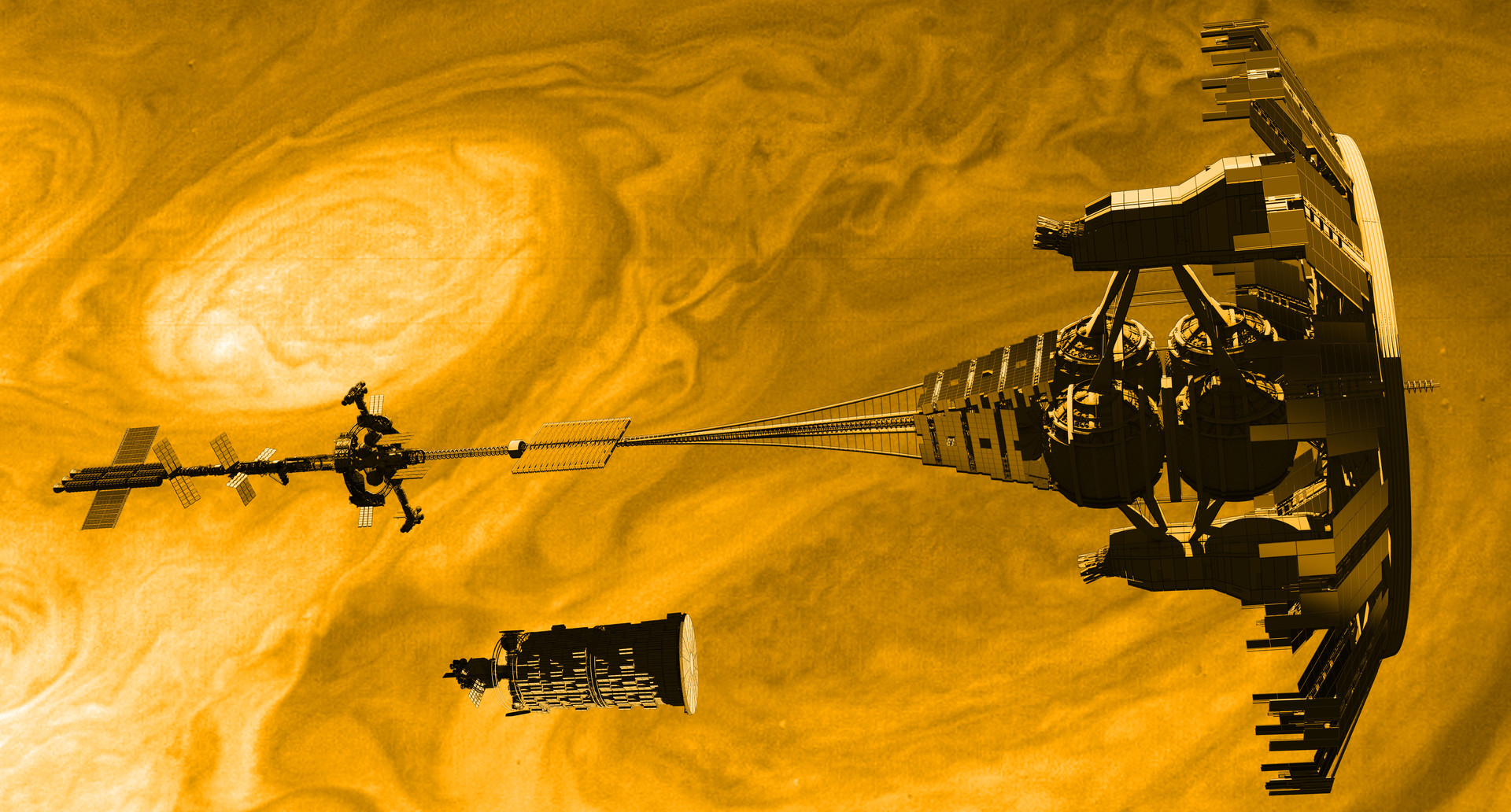 |
| ROBOTS V DINOSAURS |
General ship design points
A few final points to consider:
- Even though fusion torches allow for Brachistochronic trajectories between orbital bodies rather than relying on Hohmann transfers, mass is still an important consideration. Ships will be built as spartan and barebones as possible to save on fuel. This won't have a mechanical element (I'm not masochistic enough to try and puzzle out a relationship between hull and fuel) but is more of a descriptive one - think exposed bulkheads, plain decoration and minimal personal effects.
- Most crews will spend the majority of their time in zero-g outside of rotating quarters. Corridors and walls will generally be rounded with padding (to prevent too much damage when losing control in zero-g or, more likely, being suddenly subject to a different g-force during an unexpected burn) and grab loops regularly spaced to anchor and propel oneself while weightless.
- Fancy tech with bells and whistle is great but when you're travelling through a medium of certain death in a sealed metal can you want reliability above all - manual backups and workarounds, robust computerisation, the works. This is so I can have Alien-style retrofuture style tech justified in-game.
- Ship combat is deadly - expect even unarmed ships to possess some degree of armour. As a corollary to this many battles will end with one side surrendering when their radiators have been slagged and they need to shut down their reactor to prevent themselves from roasting alive.
- In terms of ship structure you'll see a difference between explicitly military ships and not - combat vessels will want to concentrate their mass as much as possible in order to armour up their vital components, civilian ones probably don't mind spreading out in a length as it's cheaper - but most spacecraft will be built upon similar lines: thrusters, power plant and fuel towards the back, cargo space in the midsection and crew-critical areas at the other end. Alternatively, ships could use a more spherical shape with the reactor and drives extending from the rear. There's a plethora of plausible designs. You'd probably see a lot more standardisation in the Core, with different designs becoming more common the further towards the Beyond you get.
